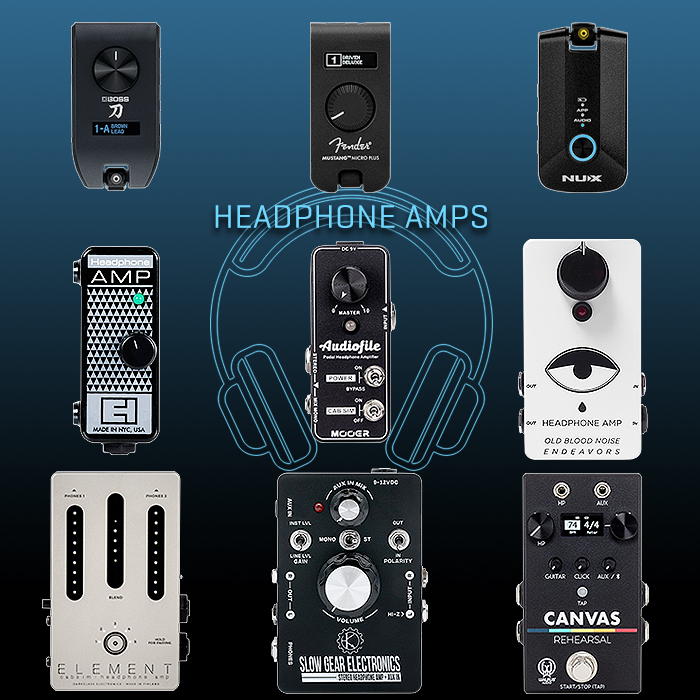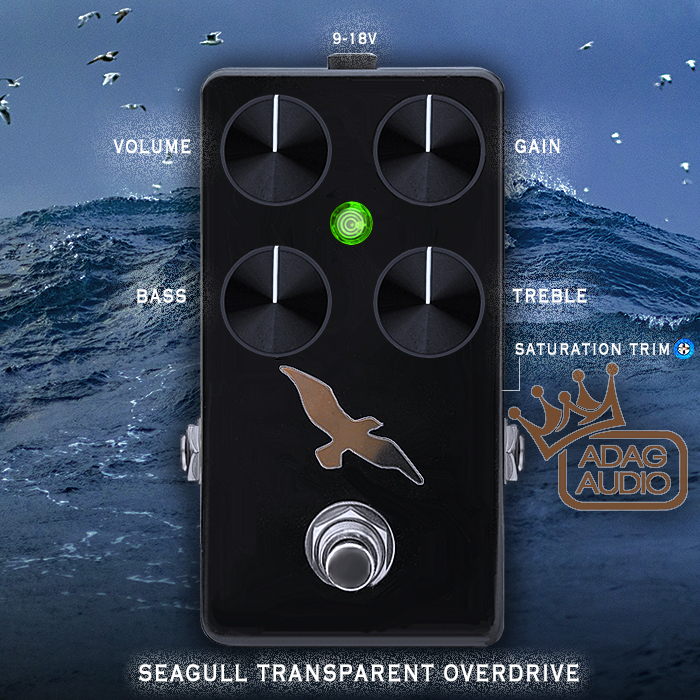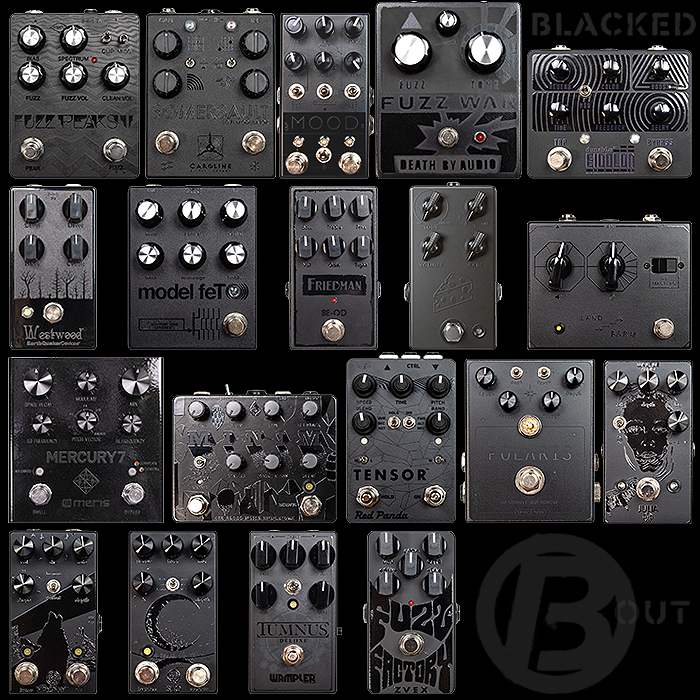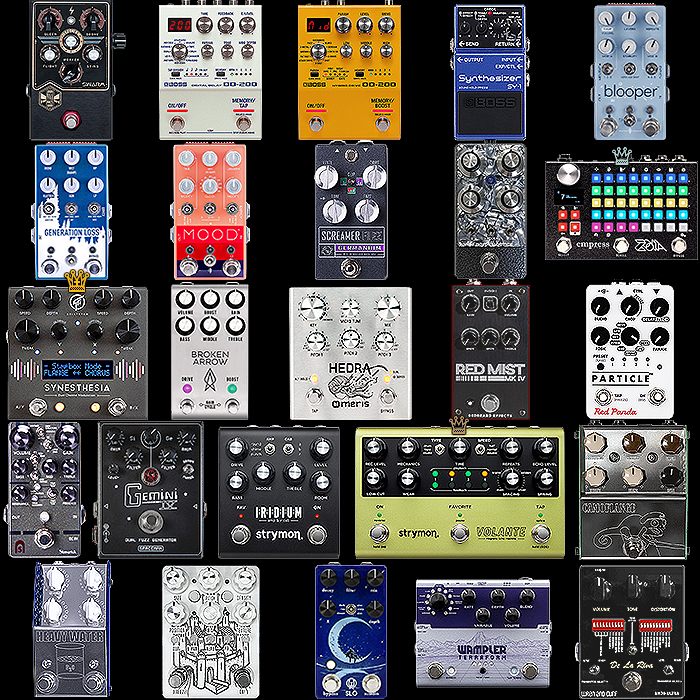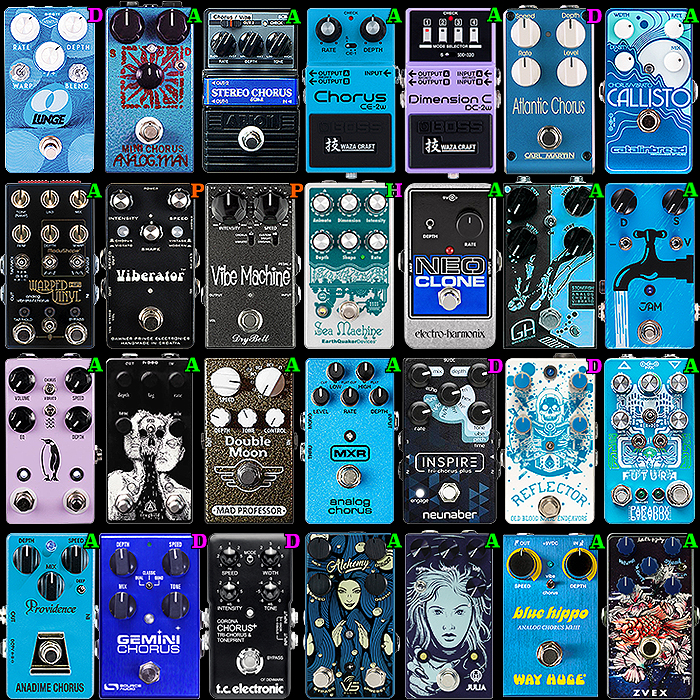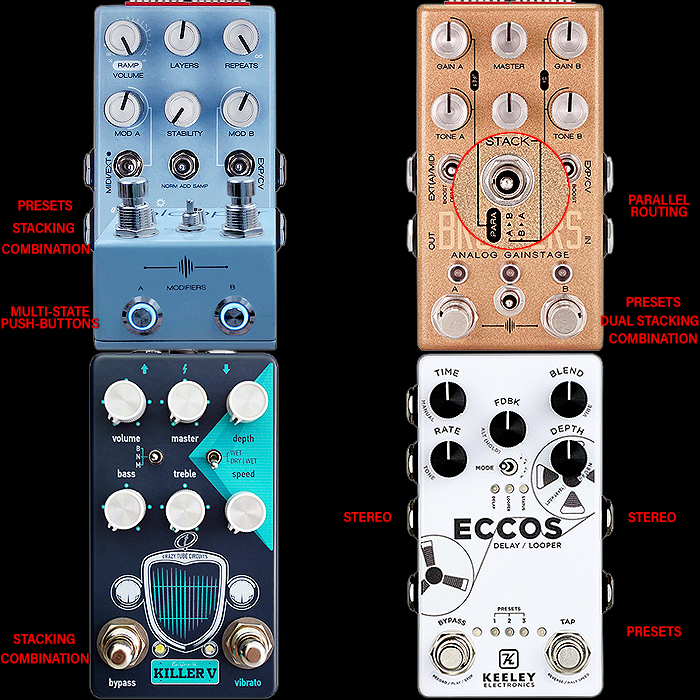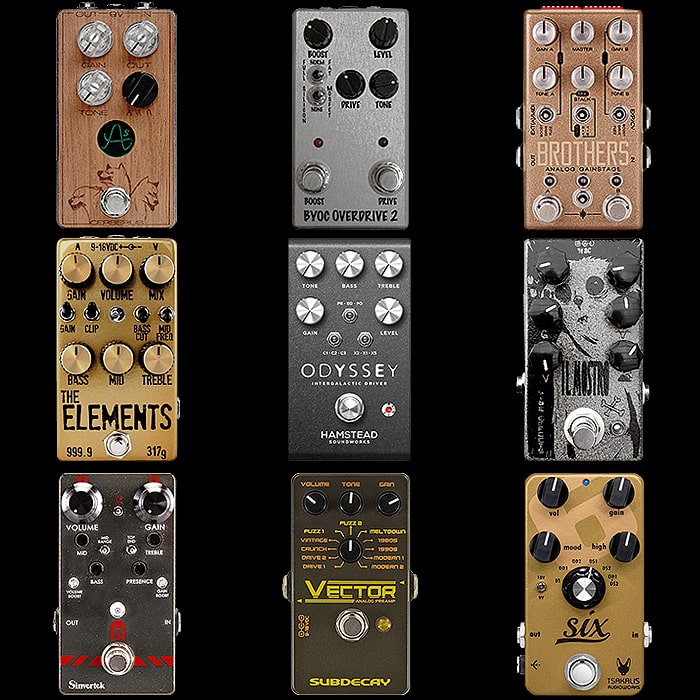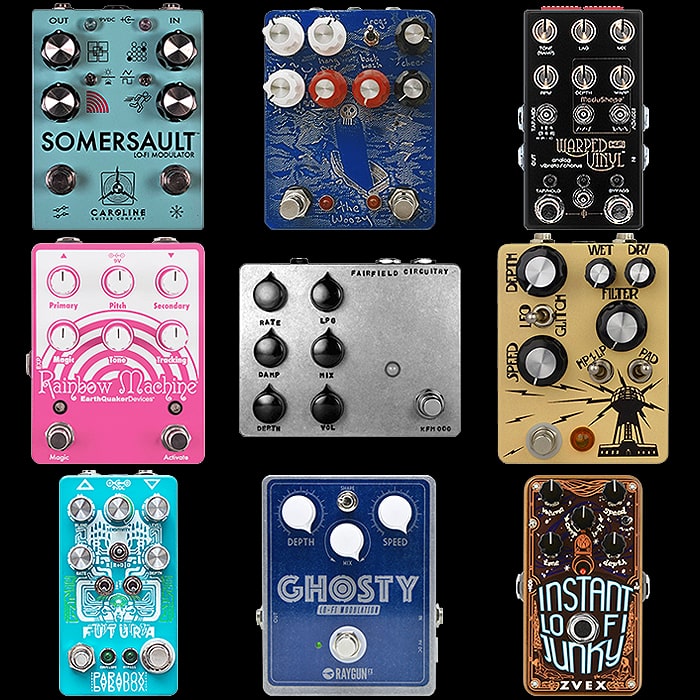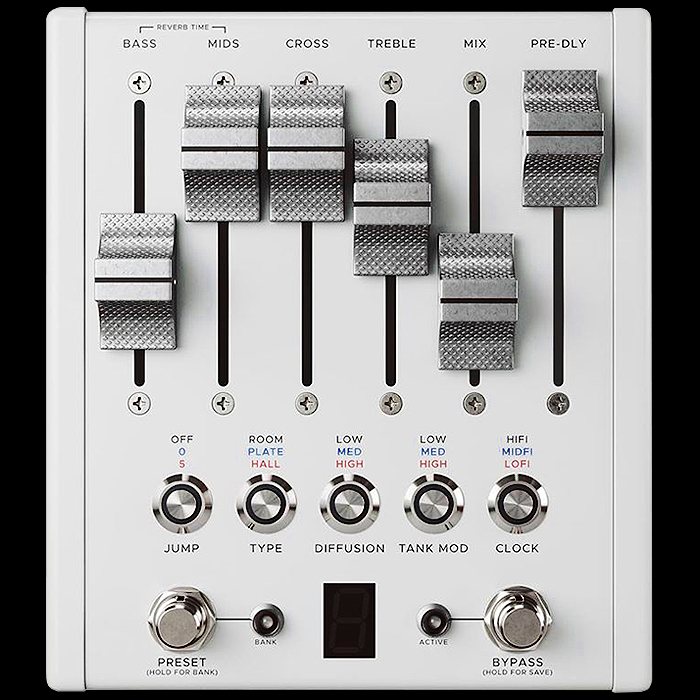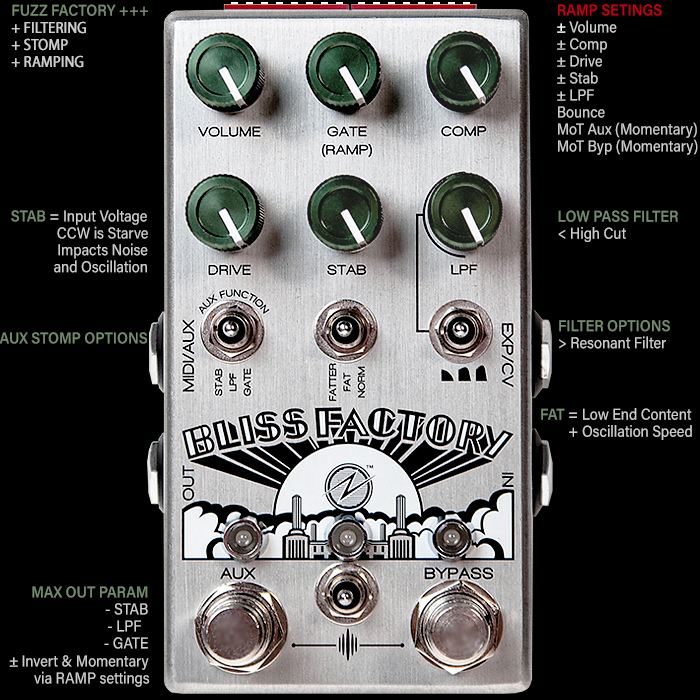Thoughts on the Chase Bliss Experimental Looper & Delay Trifecta

Chase Bliss Recently revamped its Logo and Branding and launched its 20th Production Pedal (discounting iterations and variations) - Habit : The Echo Collector.
It has also recently added two key well-loved and celebrated pedal geniuses as staff members - first Tom Majeski, formerly of Cooper FX, and then Scott Harper of Knobs_Demos fame - both existing close collaborators of Joel Korte. And while we’ve often seen leading pedal luminaries collaborate before - this is the first official team-up - in fact a genuine Supergroup of Pedal Gurus! What wonders await!
I was onboard with the Blooper Bottomless Looper pretty much from the start - but then somewhat confused by the sudden unannounced arrival of the MOOD Ambience Generator - which leap-frogged the Blooper for an early release. While I was waiting for the Blooper to materialise which it did somewhat oddly via Kickstarter at the time - the MOOD kind of caught me completely by surprise - and I was unsure of functional and features overlap and overall usability - which meant that I acquired the MOOD somewhat later than intended.
Both those pedals are of a newish tabletop breed - really better suited to keyboard and modular synth type player who can tweak all those knobs in tandem and are already well used to doing such. For those that come from a floor-based stompbox environment there is a question of compatibility, learning curve and indeed a whole process of adoption. In fact everyone I’ve seen use these fully properly does so within a tabletop setup typically.
I feel that the Blooper cannot really exist as a floor-based stompbox - such is its need for constant hands-on manipulation. While I’ve found that I can use the MOOD to a degree as a bona fide stompbox - while some of its clever applications of course really require a tabletop environment too!
So what of the Habit? Is that more a tabletop pedal or stompbox in nature - and how easily and practically can it be deployed in a floor-based environment?
Upon watching the very first videos I was unsure of the pedal’s practical stompbox potential and kind of landed in the nice-to-have camp - where I thought the pedal might require a little too much hands-on input and manipulation to be deployed practically on the floor.
Having then seen the excellent Andy Martin Demo and the output he was able to simply and effectively extract from the pedal I decided this would very much be a must have for me - and likely the most potent and practical of the trio as a regular floor-based stompbox.
These few weeks later I’m kind of back in the nice-to-have camp again as the downside of slick and efficient demos - is that you’re rarely party to all the experiments that went wrong - and failed to fully yield musical output - and that is largely the challenge with the Habit - not that there aren’t great tones and patterns possible - but that eking them out is often tricky and overly time-consuming.
Of course just using the top 3 knobs as a basic delay, and then gradually adding Modifiers and flipping output options is fairly straight forward - while the Spread and Scan controls take a long time to acclimatise to - not the theory necessarily - but successful application of those, and landing on a usable pattern!
I think Chase Bliss should probably institute practical hands-on training courses of its Experimental Trifecta - in all its major territories - or I fear that long-term a lot of these pedals will be flipped - as being just a touch too challenging for most players to use on a regular daily basis - and particular as a fairly standard operation floor-based stompbox.
Here follow my thoughts and observations on the experience of running these pedals within a complex floor-based pedal-chain environment!
Let’s hear your thoughts and insights too!:
Blooper Bottomless Looper Experimental Sampler / Looper / Modifier - $499

Controls - Ramp (Volume), Layers, Repeats, Mod A, Stability, Mod B, A Modifiers : 1 / 2 / 3, Mode : Normal / Additive / Sampler, B Modifiers : 4 / 5 / 6. Presets : Preview (Left), and Save/Load (Right), Record / Momentary Record / Play / One-Shot Record Footswitch, Stop / Undo / Redo / Trigger / Activate Footswitch - press both to Delete, Activate A Modifiers Button, Activate B Modifiers Button.[+16 Dip-switches]
Modifier Types - Smooth Speed / Dropper / Trimmer / Stepped Speed / Scrambler / Filter / Swapper / Stopper / Pitcher / Stretcher / Stutter.
Here we must start by mentioning some of the really cool innovations of this pedal - which have to be the ingenious 8 Layers of Undo / Redo that you can variably unwind and rewind with a knob. Also the incredible number of 12 onboard Modifiers via the 2 additional arcade style buttons on the front edge of the pedal. Finally, and as is different to most Chase Bliss compacts - the ability for 16 presets onboard versus the usual 2!
There's no question that this is the most full-featured compact looper our there, but that makes it quite complex in use.
I feel that this is the least stompbox-practical of the trio as so much of what id does require hands-on manipulation. I persevered with this for a good couple of months and spent days in a row trying to master its output - and I feel that this isn't really conducive to a floor-based stompbox - of all of these - this one really needs to be part of a tabletop environment - which is why it's so much more suitable for that genre of more modern guitar artists - that kind of live in the world of glitch and constant signal manipulation.
This is for sure an ingenious pedal - and I've certainly enjoyed its use to a degree - while being permanently crouched down over said pedal for a floor-based setup is a bit of a back-ache long-term - it's not really like the old delay trick of winding down the delay time, which anyone can easily accomplish - the Blooper rather really benefits from constant hands-on manipulation.
It's still an incredibly creative device and it will always have a place in my collection - while on the board it's no more than a tertiary supporting pedal for me as it really isn't wholly practical as a floor-based stompbox!
I would love to hear how you are using your Blooper - and if any of you use one regularly within a floor-based setup?
Key Features
- Up to 32 Seconds of Looping (Note : Official figures say 40, while actual chronometer measure says 32!)
- Ability to Save upto 16 Loops
- 12 Modifiers
- 8 Layers of Undo / Redo
- Gradually wear out your loops with Stability
- Two channels of recordable loops modifiers
- Sampler Mode
- Delay-style loop
- Internal Modulation (Ramping)
- MIDI / CV sync and control
- Expression Control
- Mono Input / Output
- Analog Dry-thru
- Buffered Bypass
- USB Customisation
- 9V DC [-} 150mA Current Draw
- 2 footswitches, 4 toggle switches, 6 knobs and 16 dipswitches offer unprecedented control
- RRP - $499
MOOD Ambience Generator Micro-Looper / Modifier - $349

Controls - Time, Mix (Ramp), Length, Modify A, Clock, Modify B, A Modifiers : Reverb / Delay / Slip, Mode : Input Only / Input + Looper / Looper Only, B Modifiers : Envelope / Tape / Stretch, Presets : 1 / Manual / 2, Right Engage Loop Playback Footswitch, Left Apply Spatial Effects / Modifiers Footswitch.[+16 Dip-switches].
By the time I got to the MOOD I was very used to how Always-on Micro-Loopers worked - in fact in part courtesy of David Rolo's own Molecular Disruptor. I would say that overall this was the easiest pedal to get to grips with in its entirety - where David Rolo provided the left-hand Modifier trio, and the OBNE gang did the right-hand trio. This differs to the Blooper - which was largely a Scott 'Knobs' Harper project - of course with essential programming help from Mark Seel of 3 Degrees Audio.
The MOOD is well described as an Ambience Generator - which I feel is very apt - kind of adding spacey atmospheric effects to glitchy looping output.
I feel the learning curve with the MOOD is the shortest - and while it does benefit from some hands-on manipulation - once you've set up some key samples - via presets - you can deploy this quite simply and effectively too. Of course you uncover another level by applying constant manual manipulation - while I feel that aspect is overall the least necessary towards getting something really decent and usable out of this pedal.
All the controls here a are pretty practical and intuitive and if you're anything like me - you should acclimatise to this pedal relatively quickly - especially when compared to the complexity of the the Blooper!
I though that the Habit would be the most straight-forward and most suitably floor-based pedal of the trio, which is certainly true if you just deploy it as a very basic delay with some degree of Modifiers. However to get the most out of it you do kind of need some hands on manipulation, which I feel you can really get away with not applying too much to the MOOD.
What say you - is the MOOD the most straightforward of these three, and most practically usable as a floor-based stompbox?
Key features
- Granular Delay & Micro Looper
- 16 Second Delay
- 6 Modifiers
- 2 Presets
- Designed by Chase Bliss, in conjunction with Old Bloose Noise Endeavours and Drolo FX (David Rolo)
- 2 channels uniquely interact with each other to create otherworldly textures
- Internal Modulation (Ramping)
- Trails
- Momentary or Latching Bypass (Buffered Bypass)
- Analog Dry-thru
- MIDI, Expression and CV connectivity
- Mono Input / Output
- 9V DC [-] 200mA Current Draw
- 2 footswitches, 4 toggle switches, 6 knobs and 16 dipswitches offer unprecedented control
- RRP - $349
Habit the Echo Collector Experimental Delay / Looper / Modifier - $399
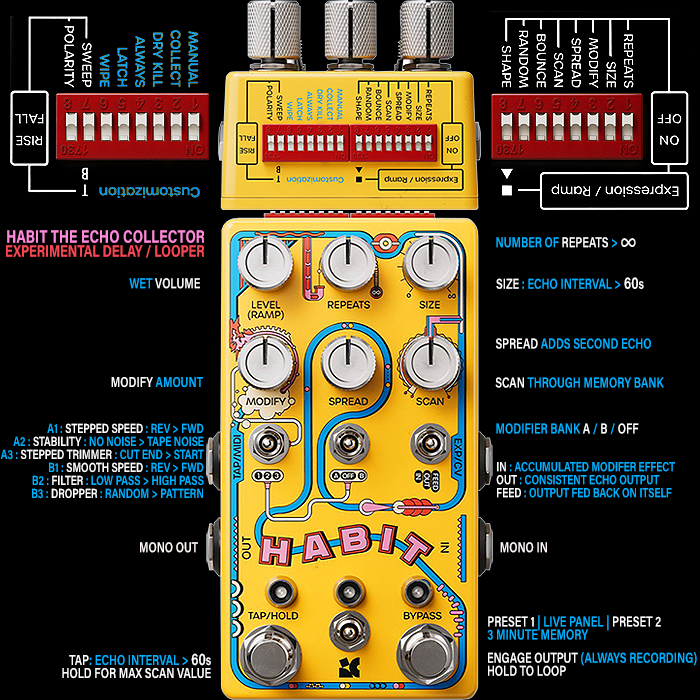
Controls - Level (Wet Volume), Repeats Number, Size / Interval, Modify Degree, Spread (2nd Delay), Scan (Memory Position), Modifiers : 1 | 2 | 3, Modifier Bank : A | Off | B, Output Mode : In | Out | Feedback, Presets : 1 | Manual | 2, Left Footswitch : Tap Tempo / Interval / Hold for Max Scan Value, Right Footswitch : Engage Output / Hold to Loop. [+16 Dip-switches]
Modifier Types - Stepped Speed / Stability / Stepped Trimmer / Smooth Speed / Filter / Dropper : Playback Errors.
So the Habit keeps vacillating in my affection - where I was at the start a touch luke-warm towards it, then energised by Andy's above demo, and now what I've had it in the chain for a few weeks I'm kind of happy I have it, while the experience is sort of one of peaks and slight anti-climaxes.
I note in the intro how most Demos obviously exclude all the failed footage - all the experiments that did not work out, and the vast amount of time it takes sometimes to get something fully musically usable. For sure easy to find interesting fills and transitions - intro and outro effects, but far more tricky to find usable portions in a live playback environment - particularly as regards the Spread and Scan controls.
I kind of understood the gist of what they were about fairly early on, but it took a few notes on the Chase Bliss Faceboook User Group to get all of that properly within context :
Spread has 1:30 Mins (90 Secs) of Memory and applies an echo to your dry signal as well as the memory. The start of Spread is from the start of the echo - of course dependent on how the top-row knobs are set.
While Scan as 3:00 Mins (180 Secs) of Memory from the start of the always-on recording / loop - where it applies an echo Not on the dry signal, just the Memory.
The idea is that you scan through those two Memory banks to find interesting patterns - either individually or in combination - which is often easier said than done!. Having the dip-switches set to Manual Scan and Collect makes things rather more elegant, but you have to pick your Modifiers carefully too.
There's no question that you can find some really cool effects and patterns - while often you're left with a lot of off-cuts on the cutting room floor.
Each of these pedals kind of revels in some of the ramdomness of creativity - but it typically requires the patience of a saint to regularly find magical usable 'bits'!
I still like each of the Trifecta featured here - each in its own way. And somehow though that the Habit would be the easiest of all to handle, while that honour for sure goes to the MOOD.
I will still keep having a go at the pedals, but they remain for now in the supporting cast rather than as essential pedalboard principals / primaries. I would of course love to hear your own experiences and insights!
Key Features
- 60 Seconds Echo Interval / Delay Time
- 3 Minute Scan Memory Bank / Loop
- 90 Second Spread / Secondary Echo Memory Bank
- 2 Presets
- Use Habit’s interconnected machinery to design new rhythms and patterns
- Trim, filter and shape your echoes with Habit’s two banks of flexible modifiers (tape delay, dissolving echoes, shrinking subdivisions and much more)
- Scan freely through the memory, or let Habit do it for you
- Collect free-form compositions by simply playing into the pedal
- Turn up the SPREAD control to listen to two moments at once. This is the key to Habit’s multi-tap abilities, but can also get into some wild cognitive dissonance. Echoes of the past and present, playing side-by-side
- Advanced connectivity and customisation options including MIDI, CV and Expression control, sync, presets, and internal modulation of any or all its knobs
- Mono Input / Output
- Internal Modulation (Ramping)
- External Tap Tempo
- Analog Dry-thru
- Buffered Bypass
- 9V DC [-] 150mA Current Draw
- 2 footswitches, 4 toggle switches, 6 knobs and 16 dipswitches offer unprecedented control
- RRP : $399
Final Thoughts

It's interesting that Chase Bliss is sill sticking to its 'Digital Brain, Analog Heart' strapline - when so many of its recent pedals aren't Analog at all.
I feel that overall I still appreciate their classic pedals a little more - especially something like the Preamp MKII which is probably my favourite pedal of all time - due to not just its immense feature set and extraordinary output and visualisation - but because of how intuitive and practically usable it is. Also how easy its is to achieve consistent solid results for each of those pedals, and without much effort or time spent at all.
With this Experimental Trifecta - they are really all about time spent really - and a lot of the time you may just get something slightly unmusical, and not fully usable within a broader context. Each of the trio kind of make you work for the results - while the MOOD kind of still requires the least time investment to master.
That is obviously still the best-selling of the trio, and I think it will continue to be - as its results are somewhat more instant and more consistent than the other two - especially at full implementation.
I still think the Habit has some uses for floor-based deployment - but using the Spread and Scan - does require fine manipulation of those tapers - kind of like the old school task of scanning vinyl record for cool samples that you could include in your set. While those could be accessed a lot more robustly and reliably really - while the Habit's output can be somewhat obtuse at times.
The Blooper is never really going to be fully usable outside of a tapletop hands-on environment, but surely the other two kind of have merit as stompboxes - where I feel that the MOOD will be my most used of the trio.
Of course it doesn't help that the final 1/3rd of my rig is stereo outpout - which means using Mono pedals can be something of an inconvenience - and doesn't adequately deliver that spatial projection I so enjoy with stereo output.
Each of these for sure has a learning curve, and I'm sure there are quite a number of tips and tricks I haven't picked up on yet - I am for sure holding onto all of these, and glad to have completed the Trifecta, but I'm not sure how much use I will get out of them long-term.
Do let me know what your own experience and insights of these are!













